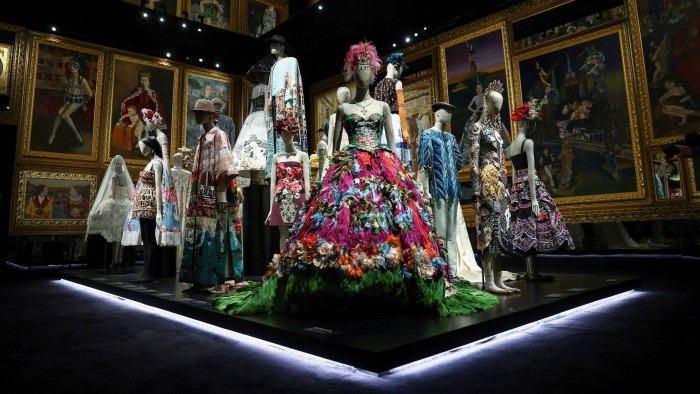Unlock the Editor’s Digest for free
Roula Khalaf, Editor of the FT, selects her favourite stories in this weekly newsletter.
A landmark exhibition opening on April 12 at London’s V&A museum will illustrate how the three Cartier brothers drew their inspiration from far and wide, the past and their present.
The three were avid travellers and collectors of art books about early civilisations, and this curiosity was to inspire a new style of jewellery. They were the first in modern times, albeit a century ago, to draw on the past to make something fresh and modern, their lush, Mughal-inspired Tutti Frutti jewels being a prime example.
Louis Cartier and his designers delved deep in their exploration of other cultures and their history, in order to garner inspiration for their jewellery.
Old civilisations have long inspired jewellery designers. In Europe, the jewellery of the Middle Ages was influenced by designs from Byzantium, while styles in eastern Europe reflected jewellery that made its way along the Silk Road during the Renaissance.
In the modern world, Dolce & Gabbana’s Alta Gioielleria collections draw on the Renaissance by recreating miniature portraits from the era, using the same techniques. These portraits — of such figures as Italian noblewoman Beatrice D’Este — are then set with jewels and worn as large pendants, much as they would have been during the Renaissance.
The brand has incorporated other historical elements in its Greek-inspired high jewellery collection, such as micro-mosaics or authentic Hellenistic coins. The collection is on display until April 2 in the brand’s Du Coeur à la Main exhibition at the Grand Palais in Paris.
In Athens, Ilias Lalaounis spent 60 years building a museum showcasing classical Grecian and Byzantium treasures that became the soul of the Lalaounis brand. “The essence of our creations is deeply rooted in ancient Greece, a rich source of inspiration throughout its history, from Neolithic times to the Byzantine era,” says Demetra Lalaounis, director and daughter of the founder. “Living in Greece, inspiration is all around us; we breathe it and live it every day.”
Drawing on ancient, handcrafted techniques such as hand-woven filigree and hand-hammered finishes, her sister Maria Lalaounis, the brand’s creative director, experiments with volume and the surface rendering of the gold to create pieces with a modern aesthetic that feel contemporary and are highly wearable.
As with Lalaounis, cultural heritage can have a powerful influence on designers: much of the jewellery by Krishna Choudhary of Santi contains gemstone treasures from the family’s archive in Jaipur. He references the 16th- and 17th-century Mughal discipline of design in the geometry and patterns of the metal in which these jewels are set, forming modern heirlooms. “I want to be unconventional, think about how a jewel can be more approachable and subtle, but still have the Mughal soul,” Choudhary says.
For example, he has an impressively large portrait-cut diamond in what might be considered an industrial-style hexagonal setting for a pendant, but the pattern is Mughal-inspired. He also plays on the use of matt-finished metals, mostly dark titanium with a bit of rose gold, for modernity.
“I am always researching about stones, about design, revisiting and reimagining patterns and putting them in a different context in terms of colour, and of positive and negative space, maybe inspired by Mughal architecture and a contemporary art exhibition,” Choudhary says, explaining his ideas for Cartouche-design ruby earrings.
The Materials of the Old World collection by Glenn Spiro and his son Joe illustrates the innovative way the pair combine unique stones with ancient artefacts to create strikingly modern jewels. They share a magpie eye for interesting elements, such as the gold Baoulé decoration from west Africa and antique amber jewels suspended on a torque that is a design rooted in classical antiquity.
“We work with a lot of generational dealers and families, usually in Europe, but sometimes you have to travel far and wide to find exceptional things,” says Joe Spiro. “We spend an obsessive amount of time sourcing these materials.”
A certain playful irreverence to the Spiros’ materials marks their work. “I think when you find juxtapositions between old and new or black and white, the relationship is symbiotic,” says Joe.
The idea of using something antique to create a new treasure is not limited to Europe. Hong Kong-based jeweller Austy Lee goes to antique fairs in Japan to forage for elements he can use in his jewellery. Artefacts such as Japanese menuki, shakudo, lacquerware and Satsuma-ware are combined with jewels in modern, exquisitely detailed earrings and brooches.
“My habit of collecting antiques stems from the fact that each antique is a fragment of history and culture,” says Lee. “It contains the cultural essences of various ethnic groups and the author’s unique understanding and interpretation of that culture.”
He throws himself into studying these subjects and exploring them often leads to bold and innovative ideas for new creations. Thus, from ancient treasures, new heirlooms are born.
Read the full article here

